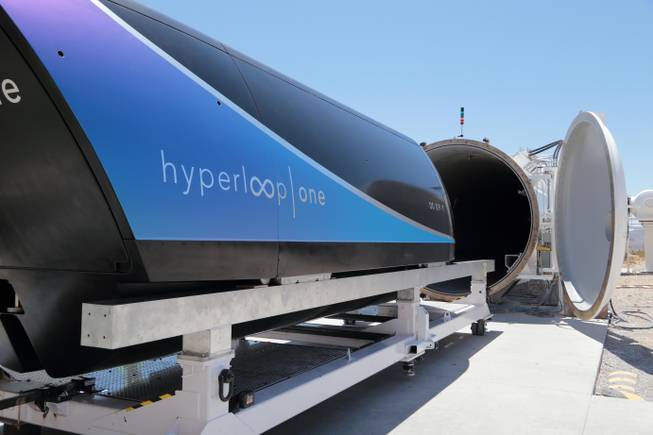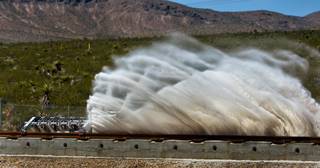
Courtesy of Hyperloop
Hyperloop One XP-1 achieved a speed of 192miles per hour in a test Saturday, July 29, 2017, company officials said.
Sunday, Aug. 13, 2017 | 2 a.m.
The hyperloop, Elon Musk has boasted, could whisk you from New York to Washington in 29 minutes. Other maglev boosters sell similar dreams: San Francisco to Los Angeles in under 30. Dallas to Houston; Portland, Oregon to Seattle; Orlando, Florida to Miami in the same.
The half-hour trip is something of a mystical notion in transportation. These visions of the future sound seductive in part because half an hour is, in fact, roughly how long many of us spend getting to work. The typical American commutes 26.4 minutes, one way, according to the American Community Survey. In metro New York, with nearly the longest commutes in the country, that average is 36 minutes.
Of course plenty of workers trek less or much more, but average U.S. commute times have budged only modestly over the last 35 years, since the census began asking about them. International studies have shown similar half-hour patterns. History even hints that the Romans traveled about the same, when most people went everywhere on foot.
The curious stability of the half-hour average commute means that when bullet trains — or autonomous vehicles, or whatever innovation comes next — link two places by that much time, they won’t just open up plausible new weekend getaways and airline alternatives. They will also potentially restructure daily life: where people live, what jobs they hold, how cities expand over time.
“What Musk correctly realizes is that there will be a huge market with maglev or hyperloop technology for the places it connects in 30 minutes,” said Jesse Ausubel, an environmental scientist at the Rockefeller University. “Any pairing that you can fit into that more or less one-hour round trip, the traffic will multiply immensely,” he said, referring to the volume of travelers.
People priced out of Brooklyn could move to Baltimore. Congressional aides would commute to Philadelphia. Whole cities — and labor and housing markets — would fuse together.
The hyperloop is a wild hypothetical. But one company, HyperLoop One, is doing trials at a plant in North Las Vegas, and Ausubel’s point stands on two related patterns from history. When you give people greater speed, they don’t use it to save time; they use it to consume more space. As a result, cities have spread outward as transportation technology has evolved. Horse-drawn carriages enlarged pedestrian towns. Streetcars enabled streetcar suburbs. Highways made exurbia possible.
What, then, will cities look like with true high-speed rail, or autonomous cars, or even the hyperloop? What happens when 30 minutes of time buys you not 2 miles, or 10, but 200?
Transportation futurists partly anticipate this question (if not all the ripple effects their innovations will bring): “We’re not selling transportation,” the company Hyperloop One says. “We’re selling time.”
And time, in transportation, means territory.
Starting at the 30th Street Station in Philadelphia, a city once crossable on foot, the transportation analysis consultancy Conveyal plotted for us how far a person can travel in 30 minutes by foot, by transit and by car today. We then made some predictions about what the future of high-speed rail and autonomous cars could look like for the same commuter setting out in the middle of the Northeast corridor.
The general law of the 30-minute commute is known as Marchetti’s constant, named for the Italian physicist Cesare Marchetti, a mentor to Ausubel. Marchetti picked up the work of Yacov Zahavi, a transportation engineer who theorized in the 1970s and ‘80s that people have a fixed travel-time budget. We allocate part of our day to getting around. And that amount, about an hour, Zahavi argued, holds steady no matter where we live or how we travel.
Marchetti noted supporting historical clues: Ancient Rome, Persepolis and Marrakech were about 5 kilometers across, or the maximum distance most people can travel in an hour on foot. He diagramed the growth of Berlin, which appeared to expand concentrically as transportation advances enlarged the land people could cover. He found it not coincidental that modern-day prisons still allow inmates one humane concession — the freedom to pace for an hour outdoors.
“From our anthropological point of view, humans are territorial animals,” said Ausubel, who wrote numerous papers with Marchetti on the topic. “So they seek to maximize range, which equates with resources. And those resources can be jobs or education, or fields for rice or wheat, or social life.”
We’re hard-wired to roam farther, they argue, when more speed allows us to. (By this same theory, delays in the New York subway disturb something deeply embedded in the human mind.)
Researchers today are not universally sold on Marchetti’s constant. Some developing-world cities have monstrous commutes. Alex Anas, an economist who has modeled the future growth of cities like Chicago, finds that commute times stay relatively stable even as population and developed land area grow. But that’s because the distribution of jobs and the behavior of workers shift in response to congestion, he says. It’s not because humans have some innate hourlong travel budget. “Economists don’t buy that,” Anas said.
Part of what Marchetti described is proved by history.
“In the past, when you put in new transportation lines, cities grew further away — we know that is a fact, with or without Marchetti,” said Carlo Ratti, director of the Senseable City Lab at MIT, which has tried to validate Marchetti’s theories using commuters’ cellphone data.
In the future, superfast trains will put a twist on this picture.
“What we’re going to see with some of these new proposals is not necessarily that cities will grow much bigger,” Ratti said. “But we’re going to see two cities become one, in terms of culture, in terms of the labor market, in terms of universities.”
Philadelphia and Washington could become linked the way Manhattan and Brooklyn are today, if the travel costs are comparable (recall, before approval of the New York subway, that the two boroughs were separate cities).
Such an agglomeration then has all kinds of implications.
“The diamond district, the opera, the brain surgeon — the things that are very rare can now service a larger population,” said Luis Bettencourt, who heads the Mansueto Institute for Urban Innovation at the University of Chicago. Cities could start to specialize even more than they do today. “It could be that you have to go to Boston for surgery, and New York for the arts, and Philadelphia for something else.”
In the Northeast corridor, we don’t quite need hyperloop-level speeds to get there. Conveyal modeled a high-speed rail line, similar in route to the Acela, that reaches 300 mph. That’s a little faster than the fastest normal operating speed for a train in the world today, the Shanghai maglev. With direct service, it would take you from Philadelphia to Wilmington, Delaware, in 10 minutes, to Newark, New Jersey, in 18, to New York’s Penn Station in 21 and to Washington’s Union Station in 29.
A rail line that fast would effectively link the two city centers as if they were no farther apart than Times Square and the Barclays Center.
Autonomous vehicles have a murkier future. They could support denser cities by eliminating parking spaces and enabling efficient ride-sharing. Or they could create even more sprawl. They may give commuters greater speed — even without higher speed limits — by reducing congestion and car wrecks, or with vehicle platooning and synchronized traffic lights. (In our predictions, we assume that mass adoption of autonomous cars could mean travel that is about 33 percent faster.)
That picture, though, depends on whether autonomous vehicles make up the entire market, or just part of it. And they could wholly upend Marchetti’s theories: If a car becomes a traveling office, will people even mentally measure their commutes as “travel time”?
Marchetti fantasized about the future long before Musk did. He and Ausubel even developed ideas for maglevs that traveled in low-pressure tubes. Before today’s hyperloop slogans, Marchetti mused about Casablanca-to-Paris in just 20 minutes.
“In other words,” he wrote, “a woman in Casablanca could go to work in Paris, and cook dinner for her children in the evening.”
Whether that idea thrills or alarms you is another question.


Join the Discussion:
Check this out for a full explanation of our conversion to the LiveFyre commenting system and instructions on how to sign up for an account.
Full comments policy